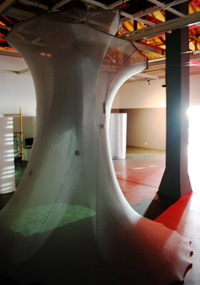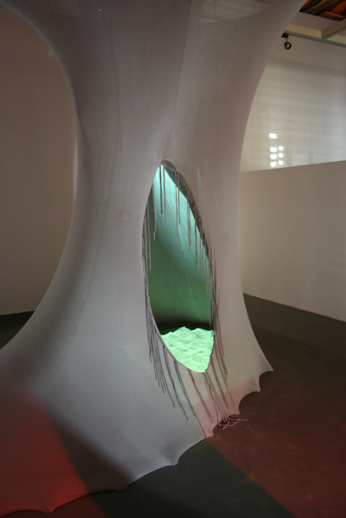Ephemeron 2009 |
|||
| a reponsive audiovisual sculpture by Barry L. Roshto, Eleni Panouklia, John Frans Holder and Sally Pryor |
|||
|
|||
Ephemeron was created by artists from different countries who were brought together by the e-MobilArt Project:
The artists collaborated both face-to-face and online, starting off in Greece. A source of inspiration came from the work of Nikos Kazantzakis: “I am an ephemeral being, frail and weak; full of mud and dreams”. Kazantzakis talked of “…transform[ing] all the pain and struggle into dreams and, as far as possible, glorify[ing] the ephemeron, making it a song” [trans. Eleni Panouklia]. The word Ephemeron is derived from the Greek word ephemeros, meaning "daily; lasting or living only a day," Ephemeron, the artwork, invites an emotional engagement with the eternal, ephemeral human epic, the song of pain and struggle, love and loss, the past (both tragic and glorious) and the future (hopeful or possibly cataclysmic). Ephemeron’s biomorphic shape is itself a mirror of the process of living: the uncertainties, the emotional inconsistencies, the encumbrances of the physical body, family and cultural ties. The audiovisuals also mirror that process. There are two simple elements: a video abstraction of the surface of a body of water and a soundscape generated in real time from recordings of traditional songs. These elements portray the tension between physical limitations and spiritual/emotional aspirations. The water is genesis, both evolutionary and biological; the songs, a record of shared experiences, a collective attempt at transcending physical reality, and most especially an absolute, direct method of emotional communication. On the one hand, nature, on the other, nurture. Ephemeron offers a responsive environment; it is a site-specific installation, a soft biomorphic kinetic sculpture, made of an elastic textile suspended from the ceiling, stretched downward and anchored to the earth by the weight of a sandy floor. This membrane forms the outer skin of a virtual organism of light and sound. Upon entering the structure, the visitor becomes part of the organism, causing the barely audible soundscape to become more emotionally engaging, revealing increasingly coherent fragments of traditional songs. As the visitor takes time to pause, sense and reflect, the video also transforms, subtly integrating the viewer into the object and (perhaps) rendering the invisible, visible, the intangible, tangible. The songs serving as material for the interactive soundscape are archetypal and sung in several languages. Traditional folksongs are an affirmation of our collective experience, one that transcends generations, spanning time and space. Their emotional significance is derived from specific moments in our ephemeral existence. When a visitor interacts with Ephemeron, the increasingly coherent song fragments have the potential to connect at the more conscious, verbal level and at a primordial emotional level that transcends language barriers completely. The shimmering ripples of the projections across the sand offer the visitor the opportunity to feel she is sinking into a deeper level of collective consciousness, to remember that we exist only as fleeting fragments of memories in our own consciousnesses and in those that we have touched, to be reminded that in the end, we are only minute drops, making ripples in the eternal pool of time and space |
Ephemeron was exhibited at the Thessaloniki Biennale Technically, there are two computers involved in creating Ephemeron. The first computer uses Max/MSP/Jitter to dynamically generate the multi-channel soundscape sent to the suspended speakers. This process of audio generation is based on just a few simple rules. The second computer uses Max/MSP/Jitter, this time to create the rippling patterns projected onto the sand. The second computer also detects visitor locations by analyizing video input; these locations influence the video projection as well as being sent to the first computer to be used to transform the song fragments
More information in Ephemeron - Sculpting a Collective Consciousness and Mapping a Collaborative Process Leonardo (Journal of the International Society for the Arts, Sciences and Technology), Berkeley, USA, Vol. 43 No.5 (2010) pp 496-7 |
||

